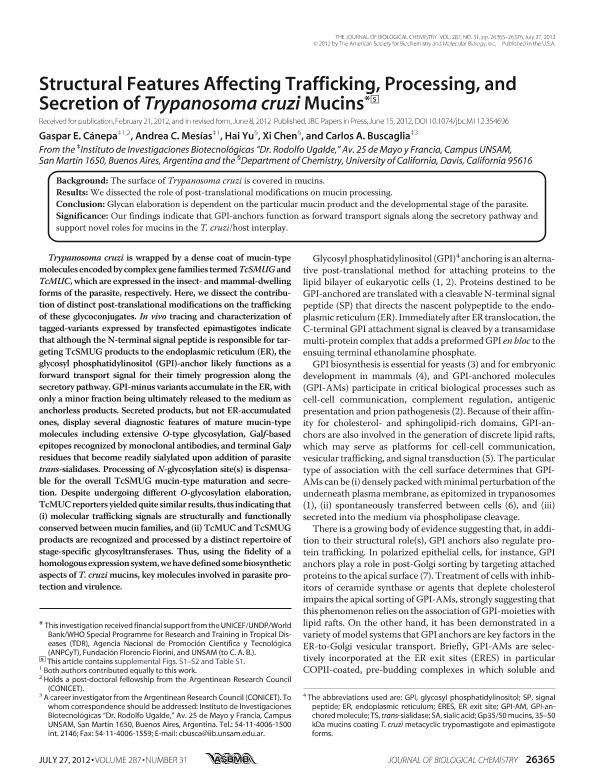Artículo
Structural features affecting trafficking, processing, and secretion of Trypanosoma cruzi mucins
Fecha de publicación:
07/2012
Editorial:
American Society for Biochemistry and Molecular Biology
Revista:
Journal of Biological Chemistry (online)
ISSN:
0021-9258
Idioma:
Inglés
Tipo de recurso:
Artículo publicado
Clasificación temática:
Resumen
Trypanosoma cruzi is wrapped by a dense coat of mucin-type molecules encoded by complex gene families termedTcSMUG and TcMUC, which are expressed in the insect- and mammal-dwelling forms of the parasite, respectively. Here, we dissect the contribution of distinct post-translational modifications on the trafficking of these glycoconjugates. In vivo tracing and characterization of tagged-variants expressed by transfected epimastigotes indicate that although the N-terminal signal peptide is responsible for targeting TcSMUG products to the endoplasmic reticulum (ER), the glycosyl phosphatidylinositol (GPI)-anchor likely functions as a forward transport signal for their timely progression along the secretory pathway. GPI-minus variants accumulate in the ER, with only a minor fraction being ultimately released to the medium as anchorless products. Secreted products, but not ER-accumulated ones, display several diagnostic features of mature mucin-type molecules including extensive O-type glycosylation, Galf-based epitopes recognized by monoclonal antibodies, and terminal Galp residues that become readily sialylated upon addition of parasite trans-sialidases. Processing of N-glycosylation site(s) is dispensable for the overall TcSMUG mucin-type maturation and secretion. Despite undergoing different O-glycosylation elaboration, TcMUC reporters yielded quite similar results, thus indicating that (i) molecular trafficking signals are structurally and functionally conserved between mucin families, and (ii) TcMUC and TcSMUG products are recognized and processed by a distinct repertoire of stage-specific glycosyltransferases. Thus, using the fidelity of a homologous expression system, we have defined some biosynthetic aspects of T. cruzi mucins, key molecules involved in parasite protection and virulence.
Palabras clave:
Trypanosoma Cruzi
,
Mucins
,
Glycosylation
,
Secretion
Archivos asociados
Licencia
Identificadores
Colecciones
Articulos(IIB-INTECH)
Articulos de INST.DE INVEST.BIOTECNOLOGICAS - INSTITUTO TECNOLOGICO CHASCOMUS
Articulos de INST.DE INVEST.BIOTECNOLOGICAS - INSTITUTO TECNOLOGICO CHASCOMUS
Citación
Cánepa, Gapar E.; Mesias, Andrea Cecilia; Yu, Hai; Chen, Xi; Buscaglia, Carlos Andres; Structural features affecting trafficking, processing, and secretion of Trypanosoma cruzi mucins; American Society for Biochemistry and Molecular Biology; Journal of Biological Chemistry (online); 287; 31; 7-2012; 26365-26376
Compartir
Altmétricas




